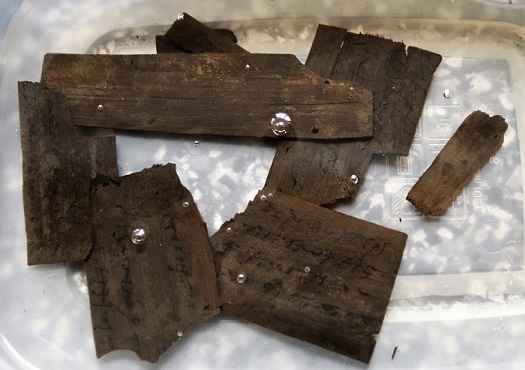Recent excavations at Vindolanda, a Roman fort on Hadrian’s Wall, have turned up some wonderful finds – some of the most exciting of which are newly discovered writing tablets. This week a press release revealed some juicy details about the new inscriptions, which have yet to undergo conservation and careful palaeographic study.
All pictures in this article are ones made available by the Vindolanda Trust in their press release and on Twitter, unless otherwise stated.

The survival of writing tablets from the ancient world is relatively rare, and when we find them they provide valuable evidence of writing in the ancient world. It is not only the information they contain, a significant historical resource in itself, that is important, but also the implications for our understanding of ancient literacy. This is something we’ve talked about a bit in a previous blog post, HERE, in the context of thinking about the recent discovery of writing tablets from Roman London.

Vindolanda is blessed with a wet climate and boggy ground (less of a blessing if you have ever tried visiting the site in the driving rain as I did a few years ago!), which means that some incredible remains have been found there, including a particularly impressive array of wood, leather and even cloth items.


It is the same environment that has allowed the survival of the writing tablets, which are made of wood. Twenty-five new ink tablets, which are inscribed in ink on very thin slivers of wood, show visible traces of writing. I have been trying to make out words from the pictures but haven’t done very well – can you do better?

Be warned however that “cursive” Latin script can be notoriously difficult to decipher. You might want to have a look at the transcription exercises on the Vindolanda Tablets Online website HERE first! One of the problems is that we are used to seeing Latin written in large, clear letters on stone, while opportunities to read the scrawl of real handwriting are relatively limited – it’s that scrawl of writing quickly in ink that we refer to as “cursive script”. Some letters might seem quite close to the shapes of letters we use today (e.g. c, h, u, etc), while others look much more strange (the backwards b especially always confuses me!).

Latin cursive letter chart from Vindolanda Tablets Online HERE. (Try writing your name or a short message!)
Special imaging techniques will be used to try to make out what is written on these new tablets, techniques that have proved very successful with the ink tablets previously found at the site (some of which you can see at Vindolanda itself, and I very much recommend a visit). However, the fact that the ink on the new finds is quite visible to the naked eye has already allowed some words to be identified. One of these is the personal name Masculus, a name already known from other tablets from the site, and probably referring to the same soldier who famously complained about a lack of beer and ordered more for his comrades in one document! (See here: Letter 628, Masculus)

As well as the ink tablets, some stylus tablets have also been found – these are wooden writing boards that would have once been covered in wax, in which a message would have been scratched with a stylus. These can also sometimes be read, as long as the message impressed in the wax made an impression on the wood below. However, because they were essentially reusable, it is often the case that there are traces of multiple messages, which makes it a bit of a nightmare to untangle them. Any inscription that is written over another erased one is labelled a ‘palimpsest’ by epigraphists, derived from the Greek for ‘scraped again’.

The new tablets from Vindolanda were discovered together in what has been described as a possible archive. This in itself is of interest because it helps us to understand something of the spatial distribution of documents, which is related to how they were used – if documents were deliberately collected in an archive, it might for example be because there was an intention to consult them again at a later stage. (Then again, we can probably all think of examples of documents that are deliberately filed but never needed again…!) A new stylus has also been found at the site, the sort of instrument that would have been used on the wax-coated tablets to impress a message, another piece of direct evidence for literacy at Vindolanda.

I’ll be looking forward to more news on the contents of the new tablets. In the meantime, why not read about all the previously discovered tablets on the excellent Vindolanda Tablets Online (provided by CSAD at Oxford)?
~ Pippa Steele (Principal Investigator of the CREWS project)



Nice article Pippa, thank you. Anything to do with this, site fascinates me.
LikeLiked by 1 person
Thank you Tracey! Vindolanda has produced such a wonderful array of finds, really remarkable.
LikeLike